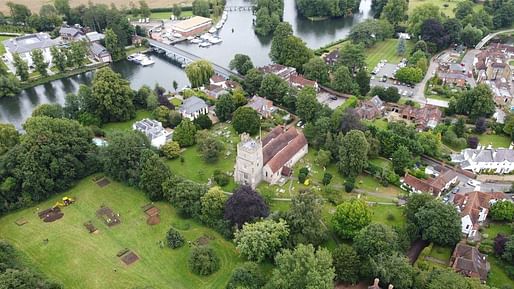

Archaeologists at the University of Reading and local volunteers have discovered a long-lost 8th-century Anglo-Saxon monastery in the historic village of Cookham in Berkshire, England. The finding provides unique insight into one of the most prominent women of the early middle ages and potentially her final resting place.
The location of the site has been a long-debated mystery until now. Written records indicate that it was once under the rule of Queen Cynethryth, the widow of the powerful King Offa of Mercia, one of the main Anglo-Saxon kingdoms. She is the only Anglo-Saxon queen known to have been depicted on a coin.
Excavating the grounds of Holy Trinity Church, one of the rumored locations of the monastery, the team uncovered the remnants of timber buildings, which would have housed the inhabitants of the space. They also unearthed a collection of artifacts including food remains, pottery vessels used for cooking and eating, a delicate bronze bracelet, and a dress pin, presumably worn by female members of the community.
"The lost monastery of Cookham has puzzled historians, with a number of theories put forward for its location. We set out to solve this mystery once and for all,” said Dr. Gabor Thomas, the University of Reading Archaeologist who is leading the excavation.
"Despite its documented royal associations, barely anything is known about what life was like at this monastery, or others on this stretch of the Thames, due to a lack of archaeological evidence,” he added. “The items that have been uncovered will allow us to piece together a detailed impression of how the monks and nuns who lived here ate, worked and dressed. This will shed new light on how Anglo-Saxon monasteries were organised and what life was like in them."
As described in the University of Reading’s release, the monastery was among many established on sites along the Thames to take advantage of what was one of the most important trading routes in England. “The stretch of the Thames in which Cookham falls formed a contested boundary between the kingdoms of Mercia and Wessex, so the monastery here had particular strategic and political importance.”
Further uncovering indicates that the layout of the monastery was organized into a series of functional zones demarcated by ditched boundaries. One of the zones shows evidence that it was used for housing and another for industrial activity, seen through the presence of a cluster of hearths possibly used for metalworking.
Dr. Thomas describes Queen Cynethryth as a “fascinating figure” who “clearly had genuine status and influence in her lifetime.”
"We are thrilled to find physical evidence of the monastery she presided over, which is also very likely to be her final resting place," he continues.
Cynethryth became royal abbess of the monastery following the death of Offa in AD 796. She is believed to have died in AD 798.
No Comments
Block this user
Are you sure you want to block this user and hide all related comments throughout the site?
Archinect
This is your first comment on Archinect. Your comment will be visible once approved.